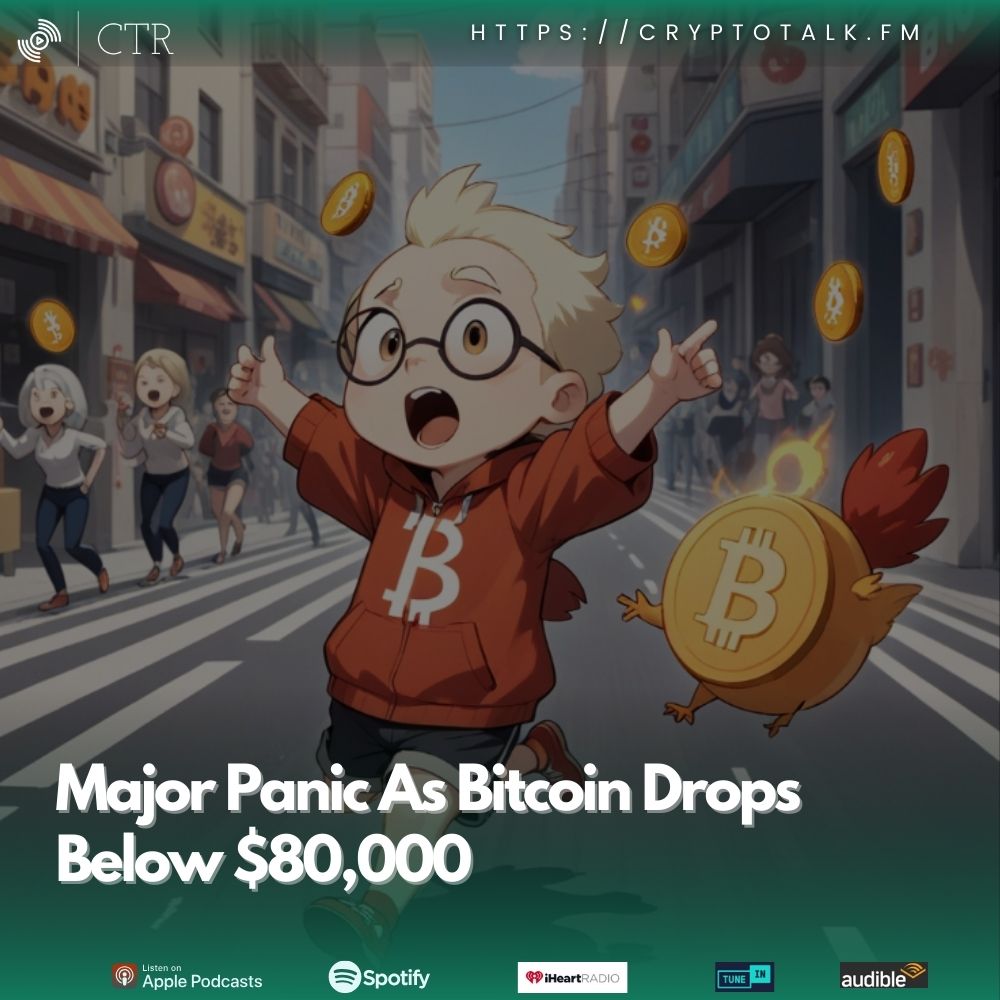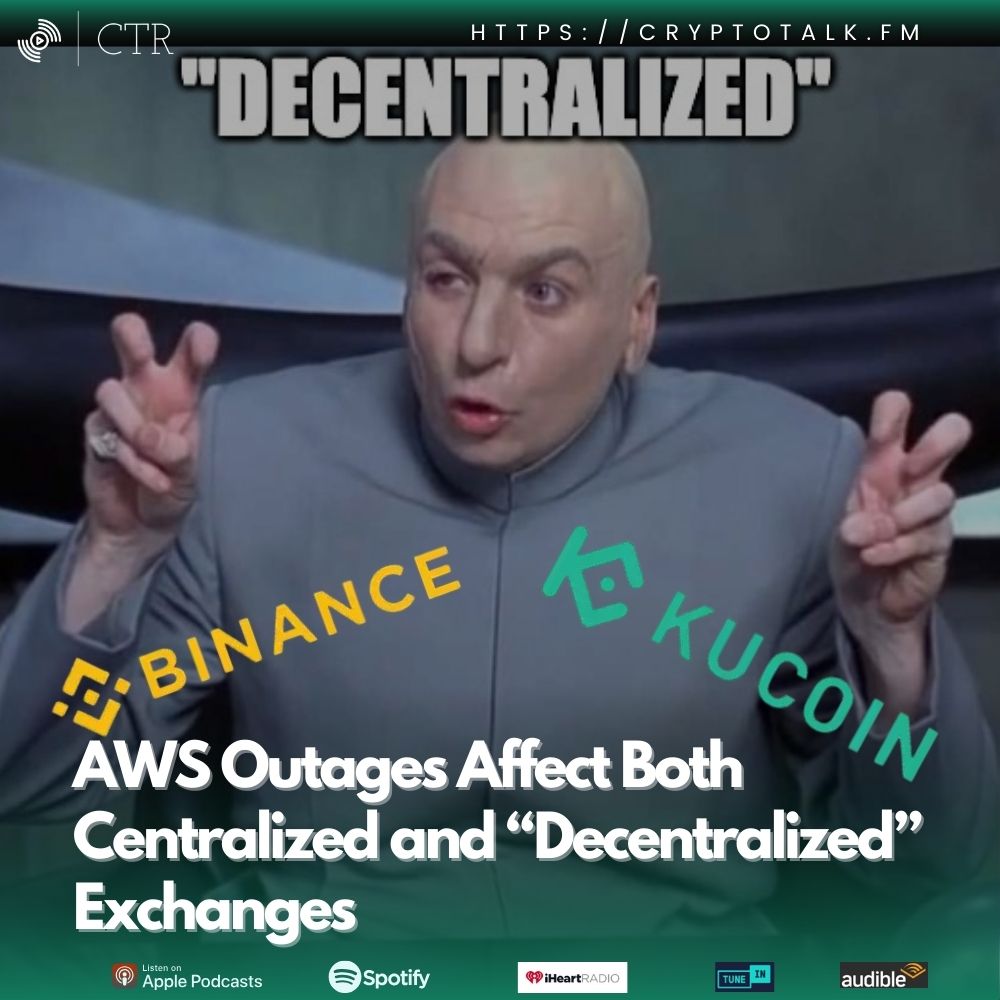[00:00:01] Speaker A: Welcome to Crypto Talk Radio, the podcast for everyday investors like you. Visit us on the
[email protected] and now here's your host, Leister.
[00:00:13] Speaker B: Thank you for that, Bailey. And welcome everybody out there in Crypto Talk radio
[email protected] it's tax season, folks. I'm not looking forward to tax season this year. There's a lot more money flew in and that's going to really put a crimp on stuff I have to do. I do my own taxes for those that didn't know. And I'm going to, I'm going to need to sit down and figure out deductions because I did a lot. There's allegedly, you know, home energy credits and all these other things that I would be eligible for theoretically. But I got to see what that looks like because money was given and contracts signed, you know, in the old year. And so I got to figure out what that looks like. The move is going to change some of that. Meaning that sometimes there's deductions and things that they allow because you needed to move and business. There's all sorts of chaos that happen that I need to wrap my head around. So that's on deck to try to find out what my tax fricking bill is going to look like. And I'm not looking forward to it, folks. I'm really not because usually it's like a 35, 40%, you know, tax and that's a lot because I still have a bill from before which was 2023. Yeah, 2023, and that one wasn't that large, but it still was kind of up there. So again, I usually am thinking it's 3540 and I did not do any withholding because I'm a business owner. I'm doing draw. So when you do, I tried to do the withhold but it turns out that that creates more chaos at the state level. So I turned it off. So now I got to figure out what does that look like in the pass through and I'm not looking forward to that business. I didn't have any, you know, I don't have any like tax liabilities on the crypto side. It's really all money, straight money. Because I, you know, I'm all J O B, you know, I own my own business.
I don't do cryptocurrency for profit. I do it cause I enjoy talking to you guys. That's how I do it. I know some of these other ones are hurting right now, some of these YouTubers, they're really struggling, they're really hurting because many of them, they're trying to go full scope into it as a business and some apparently made it, but. But most of them didn't. I think there's. I think there's. That's a dying market, in my opinion. This is an opinion of mine. That's a dying market that you can turn that kind of thing into a viable business model. You know, Ben Armstrong, bit boy, I don't know if you heard, but he got arrested and he was probably at the top of that list. I mean, there's other ones like Gokin and others, but I'm just talking within the regular routine. YouTubers, it seems that's very difficult to make a business out of, especially because crypto is nowhere. Like a lot of them got in, you know, at a point when it was peaking. Right. We're not even close to that. So who knows, Maybe it does. I don't do that. I have my own jlb, you know, and that's how I make money. And trading crypto is more of a hobby for me at this point. There are some that if they go, they go, but they're mostly a hobby and I don't watch this stuff. I'm going to be talking about some of that, but I think today's episode will be reasonably short because there wasn't a lot going on and I want to talk and focus a little bit. We do have a basic cryptonomics 101 as well. I want to chat through coindesk.com and we are going to zoom out to the month chart. I know it's a little bit painful, but we're going to zoom out to the month chart for bitcoin because it's important that we put some framework around what it is that we see and what it is that we saw.
Let's start, of course, with, you know, the past 24 hours, Bitcoin experienced quite a bit of pain. A low, well, high really, of just shy of 81,000. A low of 76,000, trending currently downwards, 76,500 ish or some odd. People are very frustrated and upset seeing the dumps and Donald Trump's being blamed for all of it. And I would just allay that concern by saying that although the tariffs are a trigger for why things are down, there's a little bit more to the story that we'll get into here in a moment. But when we looked at Ethereum, it had nowhere near the same volatility although it did go down, it wasn't near as extreme. A high of 1600, a low of 145, currently about the 147 mark. As I recorded. Nowhere near as significant and extreme as Bitcoin. To the point I said I believe that bitcoin is heavily manipulated. I, I believe that bitcoin, the run that we had near120,000 was artificial. Many of the pumps were not going to sustain. I think this is a byproduct of that prediction that it was never going to hold, that it was artificial and there was a lot of artificial money and players flowing around that now are being exposed, their pants down. It's, I, I think it's good, you know, I'd love To see an FTX level price drop, you know, back down to like 12,000 mark again, you know, so I could buy in. But something tells me we're going to rebound at some point here somewhere, maybe around, because I, I thought we would stop at 80,000. I got that wrong.
So now my next is probably somewhere not lower than 70,000, but who knows? At this point I just don't feel like it can go too much lower because we got a lot of money that would have been sitting just over 60,000 from the last all time high. So my theory is that we can't go too much lower unless there's some major catalyst that we haven't seen yet. I could get that wrong. So don't hold me to it. I'm just saying, to me, I don't think, I don't think anything's as doom and gloom as it seems. It feels like the, it feels like everything's resetting, feels like everything's just putting the price correct like it's supposed to have been all along. That's how I interpret what I see with what's going on.
We do need to consider what the impact is from the Trump administration, all the regulatory and political things going on, not just terrorists, but everything he's trying to do and set up. Speaking of stuff he's trying to do, apparently the Trump administration is disbanding one of the units that's in the Department of Justice called the National Cryptocurrency Enforcement Team. I didn't even hear such a thing. Quote, disbanded effectively immediately. I didn't know that there was an enforcement team because I assumed that the enforcement was coming directly from the sec. This strikes me as having just multiple arms, you know, all enforcing against cryptocurrency or perhaps they stepped out of bounds like they were initially scoped to simply focus on cryptocurrency, you know, criminal behaviors. And then it went out of scope and decided to go rogue and start doing all other ones. I don't know, but that one's toast. And allegedly they're going to kind of take a step back and say, you know, if you're, if you're criminal, fine, but we're not doing it like this anymore. We're doing it a little bit smarter because we want cryptocurrency to succeed with Trump establishing the bitcoin reserve and everything else. Obviously you can't have these enforcement things getting in your way.
So this, this and other things are the reason why I, I struggle to think that this is a long term damage. I think it's a short term damage in my personal opinion. But who knows? Again, I could theoretically get it wrong. I'm just not sure.
Many of these so called, you know, in. I don't even know how to call them. Let's say analysts. That's a good word. Some of these analysts keep saying, don't buy this dip. Why would they say not to buy the dip? Let's, let's analyze that for a minute, shall we? Why would they say not to buy this dip? They're saying not to buy the dip because they expect it's going to go down further. Now, it is true that you could basically sit it out and see how further down it goes, wait for a bottom and buy there. That is absolutely a viable strategy. What you also could do if you wanted is buy on the way down, because if you buy on the way down, you're doing a DCA strategy. You're saying that the cost, the effective cost of the crypto that you're buying decreases as the price goes down, which benefits you, and you end up in the same place. That, that way you're not missing out completely, because if it flips, which is going to flip, you'll still have a position that you held based on when you bought it. So I'm not telling you to buy, and I'm telling you not to buy. I'm saying that if you're listening to people like these analysts who tell you not to buy the dip, consider why they're saying it. They're saying it because they're trying to minimize your losses. You only lose if you sell. So if you buy and it keeps going down, you could just buy again and buy on the way down. But I would only do that personally if it was cryptocurrency I knew was going to rebound. Bitcoin is going to rebound there is going to rebound. Solana is going to rebound. Bnb. I would only do it if it's something where I know it's going to recover and it's not toast for the long term. I would not do it for any of these garbage bull coins. That's up to you. But I personally would only do it if I knew for a fact it's going to rebound. Then I would minimize how much I buy in on the way down to minimize the level of risk. You know, you don't throw all your stuff at it. Please don't do that. You know, make sure that it's a reasonable amount of money. If you throw all your stuff at it, you're just basically setting yourself up to fail. And I wouldn't want to see people get their stuff took by the business. If it's a garbage volt coin, you're at high risk to do that. If you look for just these main ones, you're a little bit safer, and that's what I would recommend. It's obviously your money, but I think personally, if you take the DCA strategy, there's nothing wrong with that. You can still buy on the way down and you're perfectly. It's the same. What's the difference? Right? To me, what's the difference you're gonna have in the same place. That's how I feel about it. Some may feel differently, and that's perfectly fine and acceptable.
Big picture, though, if you're one that's not in cryptocurrency right now, yes, I'd probably avoid it. If you're in it and you have a position of some kind and you're considering buying some other stuff that's on the cheap, I don't see a problem. If you wanted to do that because you're already. You're already in. Right. So you already know what risk presumably is and what it's going to be. I would not take out loans to buy in. That I wouldn't do. That, I think is stupid. It's up to you if you do it. But I think it's stupid to. To do that. So it's. It's entirely, though, up to you and what your tolerance is for how that all works.
Now let's go ahead and wrap up the remainder. I told you, it's gonna be a short episode today. We're gonna wrap up the remainder of our episode with a basic Cryptonomics. Because I had a topic brought to my attention of somebody that was curious that I thought I would Share my thoughts and my opinion about said topic. As part of this series that we do for basic cryptonomics 101, our educational series that I've been trying to do a little bit more of, the question was inspired by Hotchko, which of course crapped, and it crapped because of liquidity status. So the question really was, and I had a couple people ask, the question was, why is it or better served, how come there are situations where a token has low liquidity and thrives and other ones that have high liquidity and fail?
And this is actually easy to understand, but it's hard to see it. So you kind of have to trust the system. You can see the data around it, but it's hard to see it in action because usually it's gone in the blink of an eye first. In order to answer that question, let's talk about liquidity.
In simple terms, liquidity is the amount of money that's flowing. So if you have a project, there's the amount of money that's flowing, the amount of money it's available, the amount of money that's shifting, the amount of money that's transacting, it's money flow. Picture a water hose.
The liquidity amount is the amount of water that's flowing, right? And at some point, the water would stop flowing if somebody cut the spigot off, right? So they're. They're allowing water to flow for as long as it needs to. And if you wanted to get some of that water, you would need to approach that and take your own drink. And there would have to be enough. If multiple people wanted to get a drink, you'd have to have enough water coming out of it. Now, if it's coming from the main, we don't think of that as unlimited because obviously we do have limits on how much water is available. But for you, your perspective is that the water doesn't stop if you turn it on, it's going to keep on flowing. In cryptocurrency, and not just crypto, because there's other industries that do it. But in cryptocurrency, the concept of liquidity is not endless. It's not forever. At some point, things will stop. Money flow will stop. Transactional activity will stop. A lot of these projects cheat, because what they'll do is implement bots. The bots are creating fake transactions, so they're forcing money movement with the buys and sells. Those bots cost them money. They have to pay money in order to create the illusion of traffic. This is referred to of Course, as you know, wash trading, market manipulation tactics.
When you have a Liquidity Number, which CoinMarketCap and other sites tell you the amount of liquidity that's there, there are pools of liquidity, usually more than one, but sometimes there's only the one. But usually there's more than one. There are pools of liquidity. The pool of liquidity has to remain balanced. The balance of liquidity is comprised of the tokens that are being transacted. So there's two transactions. There's a buy and a sell, right? I'm not talking transfers, because that's a different thing. I'm just talking in straight buy. It straight line, buy and sell. In a buy and sell transaction, you need two forms of the currency in question. When you see a liquidity pair, that's the two forms of currency in question. Let's take on the Ethereum chain then. Let's simplify it.
If I took Ethereum, the token, it's the gas, right? In order to do transactions, etc. But it also can serve as part of a liquidity pool. You might have Ethereum and USD cash, right? But usually you'll have usdt, the stablecoin usdc, the stablecoin dai, the stablecoin DI on Ethereum, I say, so these pairs enable you to transfer. In this case, it's a transaction, but it's a transfer between those two. I, I have usdt, I want Ethereum, and that's the transaction. In order for your transaction to be fulfilled, there has to be an offering of Ethereum available.
Then the price is based on the balance in the pool. The balance in the pool is determined by that who created the pool and that it's maintained by the, you know, the actual traffic that's going to the pool. So that's why the price moves. When you see a price, you're not seeing the price of the token, you're seeing the price of the pool because it's the price of the pool. That means the price is constantly moving because the buys and sells are affecting what's in the pool balance. So this is why liquidity is important to consider, more so in some cases than price.
With Hotchko, I immediately saw the liquidity was nothing. It was bare bones nothing. And I saw the vast majority were bots.
Number one, the bots are going to stop at some point. They're using bots because they're hoping that people like you are gonna just FOMO into it and it'll like a match, right? It'll take fire and it'll pick up and go on its own and then they don't need the bots and it's all this. Well, in order to sustain that, there has to be some compelling reason for people to buy into it. Most of these garbage volume coin developers are banking on simple price. Fomo. I see green. There's a whole bunch of people that are just going to FOMO into it because that's what happened with Shib, that's what happened with Doge, that's what happened with many of the other ones. They think they can repeat that success when that's unlikely to happen. Therefore, when the liquidity gets out of balance, your price is going to drop. If I've got too much supply sitting out there and nobody's been willing to buy for the prices being offered, the price is going to go down until it finds a buyer. Because everything goes after whoever's willing to pay whatever price that price, it might bottom out. It might be that nobody's willing to buy it and it never goes anywhere. Well, what's going to happen to that FOMO if the price is going down? Those people are not going to buy because people like you are conditioned to do what? Buy on the green. You're not supposed to do that, but that's what you're conditioned to do. Maybe these YouTubers tell you to do it right? It's already at the all time high, it's running hot and they tell you to buy in. Now they know it's going to crap, they know that. So you're supposed to buy the discount. The reason people generally don't do that is because they think it's a dead project by that point. Most of the time, when it's not a garbage volume coin, it's going to recover from the red, which means you can ride the wave. It's up and down and up and down and up and down, down.
The ability for you to do a transaction of any kind is powered by the liquidity. The price you're going to pay, which is the price that you see is governed by what is the current price or the most recent price that that transaction is taking place with.
So you can see if you're buying in and it's just shy of a penny and it started with three zeros, you're already too late in terms of price appreciation. Unless you're gambling, rolling the dice, that it's going to go even higher. But what happens if it's already dropped two zeros, about to drop the third? Chances are it's not going to go very Much further, especially if it just launched, because there's only so much in the liquidity pool. And by the time you come along, all of the transactional activity is calmed down because everybody who is going to buy at that point has already bought. This is the challenge with newer projects. Something like a Pepe gets lucky. And even it's crap right now, but it's lucky. Official Trump got lucky, Bonk got lucky. They got lucky by encouraging people to buy in. And enough people bought in. And then it takes a lot of people to hold that. Well, you see something like a shib gaining back a zero, something like a Bonk gaining back a zero, something like Pepe gaining his zero back. Because the transactions, the trading have declined. Nobody's willing to pay those prices right now because it's already ran hot.
So the simple answer on a liquidity pool that you should take away and retain the liquidity pool is what makes trading possible.
It is comprised of two different parts, token A, token B, and allows transactions between the two. The balance of those two has. It has to be in order, or if it's not in order, you're gonna have a problem. Let's say back to my example of ETH and usdt, let's say there wasn't enough ETH in there, so somebody bought up all the eth, right? And there's not enough. You want to get two eth, there's only one ETH in there. If there's only one ETH in there, you're not gonna be able to do the transaction. It's gonna block you because there's not enough in the pool. If there's 3 ETH, it'll let you do it. But then the price is going to go up because now there's not. They need more and they want to encourage cells. So by raising the price, you're encouraging people to sell, to give more ETH to the pool so that the price can kind of balance itself back out.
You can then use in your mind the price that you see in all these different tools to understand that you're seeing the price of the pair, which is the latest price something was traded at.
And based on its start point, which is the very first, whatever that is. Let's say it's two days ago, two weeks ago. Whenever it first launched a thing, you can look at what that price was at launch compared to the price now. Chances are, if it's already skyrocketed, you're already too late. There are gamblers rolling the dice that are going to still buy in and that's fine if you want to do that. But the liquidity pool itself is what makes trading possible. The balance of the pool is what makes price happen.
You have to understand, then look at the market cap, because it is important to a degree. But if your liquidity is a fraction of the market cap, what does that tell you? In simple terms, it means of the liquidity amount, that's all that's ever available. Right now we don't. If I got 50 million in market cap and 200,000 in liquidity, what's that telling me? It's telling me that everybody's not going to get whole. Somebody's going to be ripped off. Somebody's not going to get anything unless there's more traffic. You got to have more bought in to the project. And if you're not going to sustain that velocity, it's going to crap. And it's easy to tell. So you want a really healthy balance, market cap liquidity against the circulating supply. You want to make sure that there's always a healthy amount of activity. This means getting in early is the easiest way to get a quick win. Then you take the risk that it's a, you know, a scam project. But getting in early is always the way to get the quick win out of it. And that's usually why you see many of these projects, they go do that pump and dump graph and they never recover. Because those people are smart enough to understand what I'm describing. As the liquidity increases, they're basically bleeding out of it to get their money out because they bought in crazy early before it pumped up. That's what happened with Gigachad.
That's what happened with Hotchko. That's what happened with many of these, where they got in at the right point early. They waited till hit a peak. They knew it was about to decline. They knew there's about to be less money available. So they dumped out and then never came back. If you can train yourself in how that works, you'll always win. But it's difficult because you can't know if a project's a scam. A, B, C. You can't know about sustained traffic on a project. It's not even about hype, because not every hype project gets that. A lot of these celebrity ones, they just crap, right? But I'm talking real hype. I'm talking where there's something like a bonk, right? Where it just keeps on going and going and going. So hopefully that's clear in how liquidity pools work. And their importance. And if you're trading on the descend side, it's vital that you understand liquidity pools work. It's the concept is still there on a centralized exchange but it's less apparent, it's less obvious to you on a centralized exchange. It's spot or whatever and they're basically balancing out for you to allow you to always trade even if the actual transaction didn't happen. But the flip is that you don't really own your tokens, not your keys, not your coins. So you have to choose if you stay in the central exchange. Yes, you don't have to worry about liquidity availability, but you also don't own your tokens on the descend side you have control of your tokens but it's a wah wah west in terms of money availability and that's the risk you take and what you must understand when you're doing your trades. Hopefully again that's been helpful and beneficial. Any questions? Please hit up CryptoTalk FM, hit the comments form. Let us know if you have any questions about some of that. We'll do the best we can to answer you.






